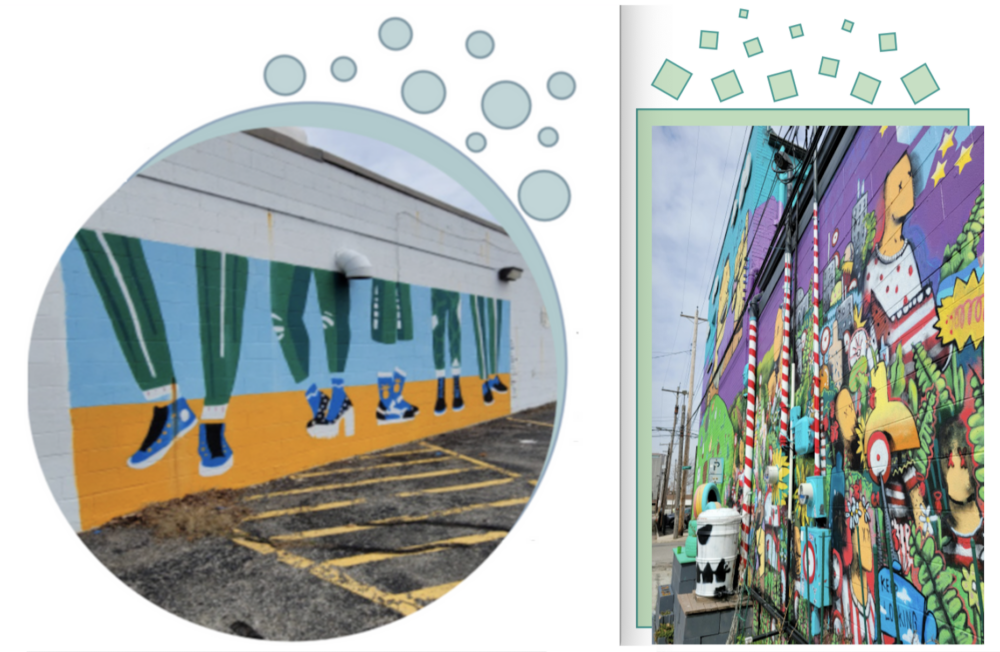
design: Jaylen Lewis
Columbus, Ohio may only be 225 square miles, but in each and every corner of the city lies an aspect of history that cannot go unnoticed. To the naked eye, Columbus looks modern, but every step taken there is taking a step through history.
According to Ohio History Connection, Columbus was founded in 1812 and from then until now, it has grown tremendously into a large and busy city. Without what happened in the past, Columbus would not be where it is today.
“Columbus has always been very popular for human occupancy because of the convergence of the Scioto and the Olentangy rivers. That had made it a popular place for groups to gather, and you also had the convergence of tribes between the Shawnee, the Delaware, the Wyandot and some other tribes over time,” Manager of Columbus Metropolitan Library’s Local History & Genealogy division Angela O’Neal said.
Like most places, Native Americans inhabited the land prior to white settlement and were there for a long time. However, they weren’t the first groups to exist in the land where Columbus is now set.
“Before those tribes, you would have had the Fort Ancient culture that would have been around the Central Ohio area. Those folks were known as mound builders, which is why you see a lot of mounds in this area. You see up by Newark the Fort Ancient earthworks and there was actually a big Indian mound right where the capital is today. But, they actually destroyed it, so they could build the capitol building,” O’Neal said.
After Native American tribes were moved out of Columbus, white settlers replaced them and began to establish different settlements across the city.
“White settlement is usually credited in 1797 with the founding of Franklinton. Franklinton came before the city of Columbus, and the city of Columbus was established in 1812 by an act of the legislature when they decided to move the capital from Chillicothe, Ohio to Columbus. Columbus was considered a better place for a capital because it was the center of the state and you could get equal representation,” O’Neal said.
In the early ages of Columbus’ origin, slavery was a very predominant issue that plagued the United States. However, Columbus was on the Northern side, so it was a city where the abolitionist movement thrived.
Kelton House museum employee Kathy Daniels said that the Kelton family, a very infamous family during Victorian Era Columbus, lived in a mansion where they would take in runaway slaves and were heavily involved in the Underground Railroad. It isn’t known how many slaves were saved because documentation of them would have been troublesome, but many freed slaves were credited to the Kelton family.
Unfortunately, Columbus was only successful with abolition; the city struggled significantly with segregation. Many aspects made living here difficult for those of black descent.
“Columbus was very against slavery and worked against fugitive slave laws. But, we also have a very strong history of segregation in our city with redlining that happened particularly in Columbus throughout the 20th century. There were actually whole neighborhoods that were slated for demolition because they were primarily African American neighborhoods,” O’Neal said.
One of the things that Columbus was most well-known for was its efforts in transportation. From railroads to canals, it was capable of transporting several different things across the land.
“Even probably more important for Columbus was the railroads. You’ve probably heard of Union Station downtown; that was the big convergence of all the rail lines and so Columbus was especially important for railroads. Farmers would ship and get their grains shipped by railroads, things would be coming in from the railroad and of course people would be getting wherever they needed to go. There was a lot of passenger rail service back and forth as people would go to see family and go for business.
“We actually had an interurban system in Columbus in the 1900s-1930s, basically a streetcar system where you could ride anywhere around the city or what’s now the Columbus Zoo. You could take it all the way to Marion, and it was basically like a light rail kind of system,” O’Neal said.
Since Columbus was very effective with its developments in transportation, it made it a city that was full of opportunity, bringing in several people from all over the country. It helped elevate people’s business and success.
Daniels said that Columbus allowed business to grow because it was a very bustling city and it grew very rapidly. Especially during the Victorian Era, many store owners were able to make a good living by choosing to live in Columbus.
With Columbus’ rapid expansion and development, more things were implemented into the city, like Ohio State University. According to OSU, the school was founded in 1870 as a land grant school, and it was first known as the Ohio Agricultural and Mechanical College.
“When the campus for OSU was built, the area where it is today was chosen because it was so far out of town that they believed the city of Columbus would never reach up that far. They wanted the campus to be in a rural area away from the city, but clearly that didn’t work as the city and Ohio State has taken over,” O’Neal said.
Columbus’ elaborate past has helped build a promising future. Several developments surround the urban core of the city expanding its growth and prestige.
“Interestingly enough, there was a plan to put a second highway around 270, that would be a second outerbelt, because they thought that as the city grew, we would need another way to drive around the city, and who knows, maybe that will happen someday.
“But, I do see Columbus as growing. In the rural areas in Ohio around Columbus, the population has declined as people move towards the city. I think those trends will continue,” O’Neal said.
Columbus has come a long way, and it will continue to grow in years to come. It’s history is vast and complex, but without it, no one could enjoy all the things that Columbus has to offer.
“What I love about Columbus and Columbus history is that there’s so much more we have to learn. We think of history as just stuff read in books and everybody already knows what’s happened, but that’s just not the case here, there’s so much more to do,” O’Neal said.
The past of Columbus and the bright future is appealing for many businesses to find a home. Columbus has been a city where businesses have found extreme success. In 1969, the first Wendy’s was founded in Columbus, whose headquarters is currently found in Dublin.
Wendy’s saw $8.5 billion sales in 2014, ranking it as the fifth most successful fast food chain in the United States, according to Business Insider.
In addition, Columbus has also proven to be a successful location for retail businesses. While it was founded in New York and not Columbus, Abercrombie & Fitch moved its headquarters to New Albany in the late 1980’s. Since then, the company has seen massive success, becoming one of the most recognizable brands amongst teenagers and young adults especially.
Lexi Sweet, the public relations manager at Experience Columbus, said the fact that many major businesses’ (such as Bath and Body Works and DSW) headquarters are in Columbus has a large impact on people’s decision to visit the city.
“This is especially true for booking meetings and convention business,” Sweet said, noting that successful Columbus businesses often attract other businessmen or women to the city. “When we attend sales calls and conferences, this is often a major selling point.”
When compared to other cities, Columbus’s successful business industry can be credited to its trained and diverse workforce, which is a result of the city’s high quality school districts. Moreover, the variety of workforce allows for Columbus to be successful in several types of industries, such as health care, manufacturing, banking and more.
“When the recession hit in 2008, Columbus did better than other parts of the state because the area does not rely on just one type of industry for employment,” Vice President of the Ohio Chamber of Commerce Julie Wagner Feasel said.
The Ohio Chamber of Commerce is a business organization led by volunteers, who focus on helping businesses find success in Ohio. Through their work, they mainly focus on advocating for pro-business legislation in the statehouse, adding to the success of Columbus businesses.
In addition to a diverse workforce, the location of Columbus is another factor that drives its businesses. The city is located in the center of both Ohio and the nation, allowing for easy transportation of goods and products through several ways, such as by air, rail, or highway.
“Many people don’t realize how important access to good transportation is to an area’s economy.” Wagner Feasel said.
While many large companies have found success in Columbus, small businesses have also been known to thrive in this city. This is largely due to the fact that the city has a well-built program in which businesses can acquire funding when needed.
“It’s provided more than $1 million in loans leveraging more than $7.7 million in total funding to 26 businesses in 2016. The city also funded 25 grants in 2015 for revitalization totaling more than $235,000,” according to CNBC.
While it is clear that Columbus is currently one of the best locations for businesses, some may wonder how long that will last. However, according to Wagner Feasel, Columbus will continue to be a place where businesses can thrive for many years to come.
“While many parts of our state are losing population, Central Ohio continues to grow. The cost of living is reasonable, the area offers a lot in the way of arts and sports and our colleges and universities continue to attract young people,” Wagner Feasel said.
Additionally, many people enjoy staying in areas that have a weather cycle for all four seasons, like Columbus; one of those people is Tom McPherson. He has lived in Columbus for 42 out of 49 years of his life.
“The four seasons of weather, the “small town feel” while also having an urban city, sports and entertainment options are all positives of Columbus,” McPherson said. “I really love it here.”
McPherson went to Saint Charles for high school and later went on to attend the Ohio State University. OSU campus on Saturdays during football season are still one of his favorite things to experience in town.
In addition to the sports and fun environment McPherson said “friends and family” are one of the biggest reasons why he has wanted to stay in Columbus for so long. It is his preferred place over Charlotte, North Carolina where he spent five years.
Troy Dersom has lived in Columbus for 49 years of his life while moving around from Columbus, Campus, Reynoldsburg, Westerville, Granville, Bexley and Lewis Center. One of his favorite areas in town is the Short North because of the art there, good restaurants and nice hotels as well.
“My extended family being here is a big reason for staying. Also, good schools, hospitals and a job market,” Dersom said.
Dersom went to Reynoldsburg High School and then went to OSU for college. Shortly after, he moved to Tampa, Florida for two years, but ultimately decided to move back.
“I really do like it here. Even after moving all the way to Florida, I missed Columbus. There is so much to do here,” Dersom said.
Currently, Dersom works for a company that creates the necessary materials for oral surgeries and will help with surgeries if it is needed at the time. He is looking forward to what this city’s potential is as he already loves it now.
“More golf courses would be good for me. Also, I enjoy seeing parts of the city that were once nice, then declined, coming back strong. Areas like Italian Village and Old Town East. I hope those types of improvements continue,” Dersom said.
Matt Black and Matt Borth have both lived in Columbus for nearly all of their lives. Black for 26 years and Borth for 42 years. They see positives such as good schools, a good cost of living and having many activities to participate in within the community.
“I love the arena district,” Black said. “Being able to go to hockey and baseball games while having plenty of restaurants and bars to visit is nothing short of ideal.”
As for the future, many people create their ideas for the city by rooting from one common goal: make Columbus the best it can be. More areas to enjoy spending time at or reducing crime levels can both improve the area.
Additionally, cleaning and constructing a cleaner environment not only to form a more visually appealing place, but to also allow other aspects of the city to flourish. “I hope they continue to clean up the surrounding areas downtown and near OSU campus so more businesses can thrive and neighborhoods can become revitalized,” Borth said.
Overall, the importance of family and friends seems to be a main reason to stay in central Ohio. This area greatly impacts many people in positive ways making it an ideal area to live for many.


